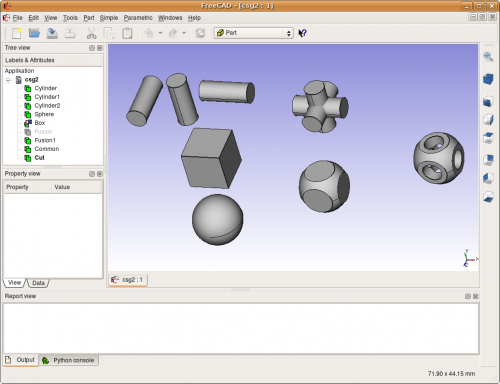Part Module/it
The CAD capabilities of FreeCAD are based on the OpenCasCade kernel. The Part module allows FreeCAD to access and use the OpenCasCade objects and functions. OpenCascade is a professional-level CAD kernel, that features advanced 3D geometry manipulation and objects. The Part objects, unlike Mesh Module objects, are much more complex, and therefore permit much more advanced operations, like coherent boolean operations, modifications history and parametric behaviour.
Esempio di forma realizzata con il modulo Parte di FreeCAD
Gli strumenti
Gli strumenti del modulo Parte sono tutti situati nel menu Parte che viene visualizzato quando si carica questo modulo.
Operazioni booleane

Un esempio di unione (Somma), intersezione (Comune) e differenza (Sottrazione)
Concetti base
Nella terminologia OpenCascade, si distingue tra primitive geometriche e forme (topologiche). Una primitiva geometrica può essere un punto, una linea, un cerchio, un piano, ecc o essere anche di tipo più complesso come una curva B-Spline o una superficie. Una forma può essere un vertice, un bordo, un profilo, una faccia, un solido o un insieme di più forme. Le primitive geometriche non sono fatte per essere visualizzate direttamente sulla scena 3D, ma piuttosto per essere utilizzate come geometrie per la costruzione di forme. Ad esempio, un bordo può essere costruito usando una linea o una porzione di un cerchio.
Potremmo dire, per riassumere, che le primitive geometriche sono blocchi di costruzione "informi", e le forme sono la reale geometria spaziale costruita su questi blocchi.
Per ottenere un elenco completo di tutti questi elementi fare riferimento alla documentazione OCC e cercare Geom_Geometry e TopoDS_Shape. Nella documentazione sono anche contenute ulteriori informazioni sulle differenze tra gli oggetti geometrici e le forme. La documentazione OCC non è disponibile online (è necessario scaricare un archivio) e si rivolge principalmente ai programmatori e non agli utenti finali. Si spera che le informazioni fornite in seguito siano sufficienti per iniziare.
I tipi di oggetti geometrici possono essere suddivisi in due gruppi principali: le curve e le superfici. Sulle curve (linea, cerchio, ...), è possibile creare direttamente un bordo, mentre sulle superfici (piano, cilindro, ...) è possibile costruire una faccia. Ad esempio, la linea primitiva geometrica è illimitata, ossia è definita da un vettore di base e da un vettore di direzione, mentre la sua forma (e rappresentazione) deve essere qualcosa di limitato da un punto iniziale e da un punto finale. E un cubo - solido - può essere creato da sei piani limitati.
Da un bordo o una faccia (forme) si può sempre risalire alla sua primitiva geometrica.
Utilizzando le forme, è possibile costruire parti molto complesse, oppure viceversa, si possono estrarre tutte le sotto-forme che compongono una forma complessa.
Scripting
The main data structure used in the Part module is the BRep data type from OpenCascade. Almost all contents and object types of the Part module are now available to python scripting. This includes geometric primitives, such as Line and Circle (or Arc), and the whole range of TopoShapes, like Vertexes, Edges, Wires, Faces, Solids and Compounds. For each of those objects, several creation methods exist, and for some of them, especially the TopoShapes, advanced operations like boolean union/difference/intersection are also available. Explore the contents of the Part module, as described in the FreeCAD Scripting Basics page, to know more.
Examples
To create a line element switch to the Python console and type in:
import Part,PartGui
doc=App.newDocument()
l=Part.Line()
l.StartPoint=(0.0,0.0,0.0)
l.EndPoint=(1.0,1.0,1.0)
doc.addObject("Part::Feature","Line").Shape=l.toShape()
doc.recompute()Let's go through the above python example step by step:
import Part,PartGui
doc=App.newDocument()loads the Part module and creates a new document
l=Part.Line()
l.StartPoint=(0.0,0.0,0.0)
l.EndPoint=(1.0,1.0,1.0)Line is actually a line segment, hence the start and endpoint.
doc.addObject("Part::Feature","Line").Shape=l.toShape()This adds a Part object type to the document and assigns the shape representation of the line segment to the 'Shape' property of the added object. It is important to understand here that we used a geometric primitive (the Part.Line) to create a TopoShape out of it (the toShape() method). Only Shapes can be added to the document. In FreeCAD, geometry primitives are used as "building structures" for Shapes.
doc.recompute()Updates the document. This also prepares the visual representation of the new part object.
Note that a Line can be created by specifying its start and endpoint directly in the constructor, for example Part.Line(point1,point2), or we can create a default line and set its properties afterwards, as we did here.
A circle can be created in a similar way:
import Part
doc = App.activeDocument()
c = Part.Circle()
c.Radius=10.0
f = doc.addObject("Part::Feature", "Circle")
f.Shape = c.toShape()
doc.recompute()Note again, we used the circle (geometry primitive) to construct a shape out of it. We can of course still access our construction geometry afterwards, by doing:
s = f.Shape
e = s.Edges[0]
c = e.CurveHere we take the shape of our object f, then we take its list of edges. In this case there will be only one because we made the whole shape out of a single circle, so we take only the first item of the Edges list, and we takes its curve. Every Edge has a Curve, which is the geometry primitive it is based on.
Head to the Topological data scripting page if you would like to know more.
